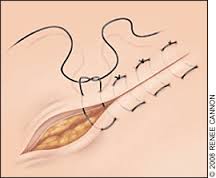Minor cuts you care like a flesh wound or abrasion.
Cut wound and the immediate area you can disinfect with a disinfectant.
Press the tissue against each other and apply bandage. The bleeding stops faster if you take the injured hand or foot at a higher level.
Pus in a wound consists of white blood cells that have been sacrificed to defend you.
Nowadays there are also moisturizing wound dressings: those would occur a better wound healing.
Previously, the Giant Puffball (Calvatia gigantea) was cut in rags to hedge wounds.
"Blood runs like mad to get around, looking for a cut or hole.” (Peter Gray)
To stop bleeding and heal wounds faster and healthy were by the Egyptians, Greeks and Romans already used cobwebs in and on wounds (eg. after fights). Use them as fresh as possible, and find clean webs. Pick dirt or insects out there and put the web at the cuts. In case of larger wounds in there. To protect the web in nature against attack of fungi and bacteria wires contain strong antibiotics. Which prevent infection of the wound. The vitamin K in the web helps to solidify the bleeding faster. The web dries out and becomes hard, but can later easily be removed with a little hot water.
(Cobweb is one of the strongest natural materials. The adhesive strength is in tiny droplets which are distributed over the wire. The spider has special hairs on its feet, with a coating which does not stick. They avoid as far as possible the adhesive droplets, and also uses walking wires without glue. Wires they make through spinnerets in the abdomen, various glands produce each their own type of web.)
Suturing
 If wounds are more than 3 mm deep and 13 mm long, they are sutured, the lateral edges are sewn or stapled. That heals faster and causes less infection and scarring. Suturing must be done within six hours, otherwise it doesn’t make much sense. The wires stay for 5 to 10 days. Watch and care internal infections.
If wounds are more than 3 mm deep and 13 mm long, they are sutured, the lateral edges are sewn or stapled. That heals faster and causes less infection and scarring. Suturing must be done within six hours, otherwise it doesn’t make much sense. The wires stay for 5 to 10 days. Watch and care internal infections.
With an arterial bleeding blood comes (squirts) with powerful fast (heart) beats from the artery.
A venous bleeding is less red, and not pulsating.
Stop bleeding by direct pressure on the wound. Possibly squint the artery by pressing him between the heart and the wound to an underlying bone. Keep the wound pressed close for 10 minutes.
If necessary, pinch, not too long. An adult has about 5 liters of blood.
As a direct and indirect pressure don’t stop the bleeding or is not possible, so only in very severe cases (severed limbs...) a tourniquet or clamp can be applied (for complete safety: never around the neck!). Put a wide band of 5 to 7 cm, 5 cm from the wound (toward heart), not on a joint. Place a pillow, roll bandage... on the vein. Tighten the belt 2 to 3 times around the limb, knot the ends together and insert a stick or pen down. By turning the belt pinches harder. Turn until the bleeding stops. Record the time (e.g. T = 18:36) on the forehead.
(That is no help to stop the bleeding, but information for emergency physicians.) Every 10 to 15 minutes the clamp should be loosened a bit for 1 to 2 minutes in order to provide blood against dying tissue. Meanwhile, do keep direct pressure on the wound.
Arteries are thick-walled and relatively easy to suture. Veins are thin-walled and difficult to sew.
There are only two types of doctors : those who postpone your funeral and those who accelerate it. (Simek)
